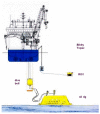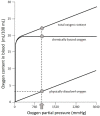How to Survive 33 min after the Umbilical of a Saturation Diver Severed at a Depth of 90 msw?
- PMID: 35326931
- PMCID: PMC8956028
- DOI: 10.3390/healthcare10030453
How to Survive 33 min after the Umbilical of a Saturation Diver Severed at a Depth of 90 msw?
Abstract
In 2012, a severe accident happened during the mission of a professional saturation diver working at a depth of 90 m in the North Sea. The dynamic positioning system of the diver support vessel crashed, and the ship drifted away from the working place, while one diver's umbilical became snagged on a steel platform and was severed. After 33 min, he was rescued into the diving bell, without exhibiting any obvious neurological injury. In 2019, the media and a later 'documentary' film suggested that a miracle had happened to permit survival of the diver once his breathing gas supply was limited to only 5 min. Based on the existing data and phone calls with the diver concerned (Dc), the present case report tries to reconstruct, on rational grounds, how Dc could have survived after he was cut off from breathing gas, hot water, light and communication while 90 m deep at the bottom of the sea. Dc carried bail-out heliox (86/14) within two bottles (2 × 12 L × 300 bar: 7200 L). Calculating Dc's varying per-minute breathing gas consumption over time, both the decreased viscosity of the helium mix and the pressure-related increase in viscosity did not exhibit a breathing gas gap. Based on the considerable respiratory heat loss, the core temperature was calculated to be as low as 28.8 °C to 27.2 °C after recovery in the diving bell. In accordance with the literature, such values would be associated with impaired or lost consciousness, respectively. Relocating Dc on the drilling template by using a remotely operated vehicle (ROV), the transport of the victim to the bell and subsequent care in the hyperbaric chamber must be regarded as exemplary. We conclude that, based on rational arguments and available literature data, Dc's healthy survival is not a miracle, as it can be convincingly explained by means of reliable data. Remaining with a breathing gas supply sufficient for five minutes only would not have ended in a miracle but would have ended in death by suffocation. Nevertheless, survival of such an accident may appear surprising, and probably the limit for a healthy outcome was very close. We conclude, in addition, that highly effective occupational safety measures, in particular the considerable bail-out heliox reserve, secured the healthy survival. Nevertheless, the victim's survival is likely to be due to his excellent diving training, together with many years of diving routine. The rescue action of the second diver and Dc's retrieval by the ROV operator are also suggestive of the behavior of carefully selected crew members with the high degree of professional qualification needed to correctly function in a hostile environment.
Keywords: accident; heliox; respiratory heat loss; saturation diving; umbilical.
Conflict of interest statement
The authors declare no conflict of interest.
Figures











Similar articles
-
Experiment of nitrox saturation diving with trimix excursion.Appl Human Sci. 1998 Nov;17(6):249-52. doi: 10.2114/jpa.17.249. Appl Human Sci. 1998. PMID: 10052222
-
On diver thermal status and susceptibility to decompression sickness.Diving Hyperb Med. 2015 Sep;45(3):208. Diving Hyperb Med. 2015. PMID: 26415073
-
Risk mitigation in divers with persistent (patent) foramen ovale.Diving Hyperb Med. 2019 Jun 30;49(2):77-78. doi: 10.28920/dhm49.2.77-78. Diving Hyperb Med. 2019. PMID: 31177512 Free PMC article.
-
Recommendations for rescue of a submerged unresponsive compressed-gas diver.Undersea Hyperb Med. 2012 Nov-Dec;39(6):1099-108. Undersea Hyperb Med. 2012. PMID: 23342767 Review.
-
[Asthma and diving with a cylinder].Allerg Immunol (Paris). 1999 Sep;31(7):245-9. Allerg Immunol (Paris). 1999. PMID: 10524270 Review. French.
Cited by
-
Oxy-Inflammation in Humans during Underwater Activities.Int J Mol Sci. 2024 Mar 6;25(5):3060. doi: 10.3390/ijms25053060. Int J Mol Sci. 2024. PMID: 38474303 Free PMC article. Review.
References
-
- Dillig B. Dräger Safety Liefert Tieftauchanlage für Norwegisches Taucherbasisschiff “Bibby Topaz”. Presse Box. Nov 23, 2006. [(accessed on 3 February 2021)]. Available online: https://www.pressebox.de/pressemitteilung/draegerwerk-ag-co-kgaa-luebeck....
-
- Subsea Bibby Reconstructs North Sea Diving Incident. Offshore Energy. Sep 24, 2015. [(accessed on 15 February 2021)]. Available online: https://www.offshore-energy.biz/bibby-reconstructs-north-sea-diving-inci...
-
- Oxygen Content in Open Circuit Bail-Out Bottles for Heliox Saturation Diving. The Diving Medical Advisory Committee. May 2, 2016. [(accessed on 29 January 2022)]. Available online: https://www.dmac-diving.org/guidance/DMAC04.pdf.
-
- Miller K. Bay-Tech Industries. 2020. [(accessed on 1 June 2021)]. Available online: https://baytechrentals.com/product/divers-umbilical/
-
- Villazon Granda A. Incident Summary 08.10.12 “Bibby Topaz.” 2012. [(accessed on 15 February 2021)]. Available online: https://de.slideshare.net/arturovillazongranda/incident-summary-081012-b....
Publication types
LinkOut - more resources
Full Text Sources
Miscellaneous

